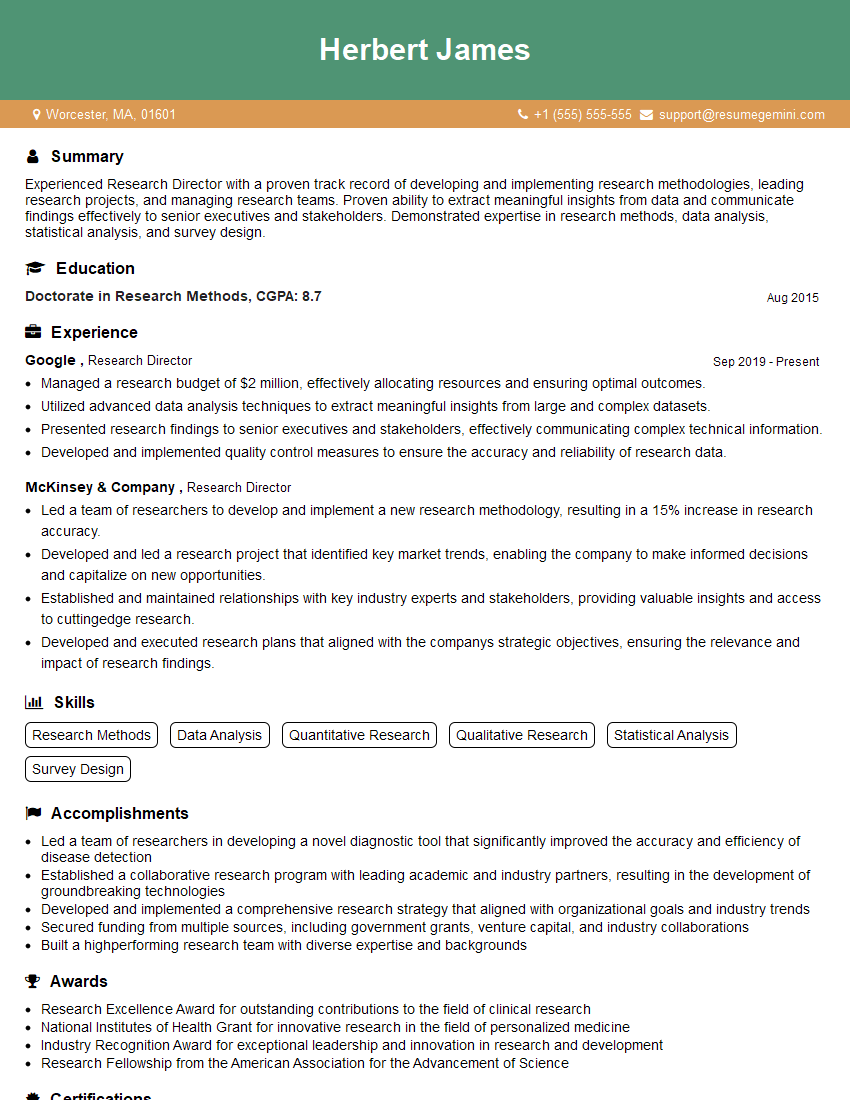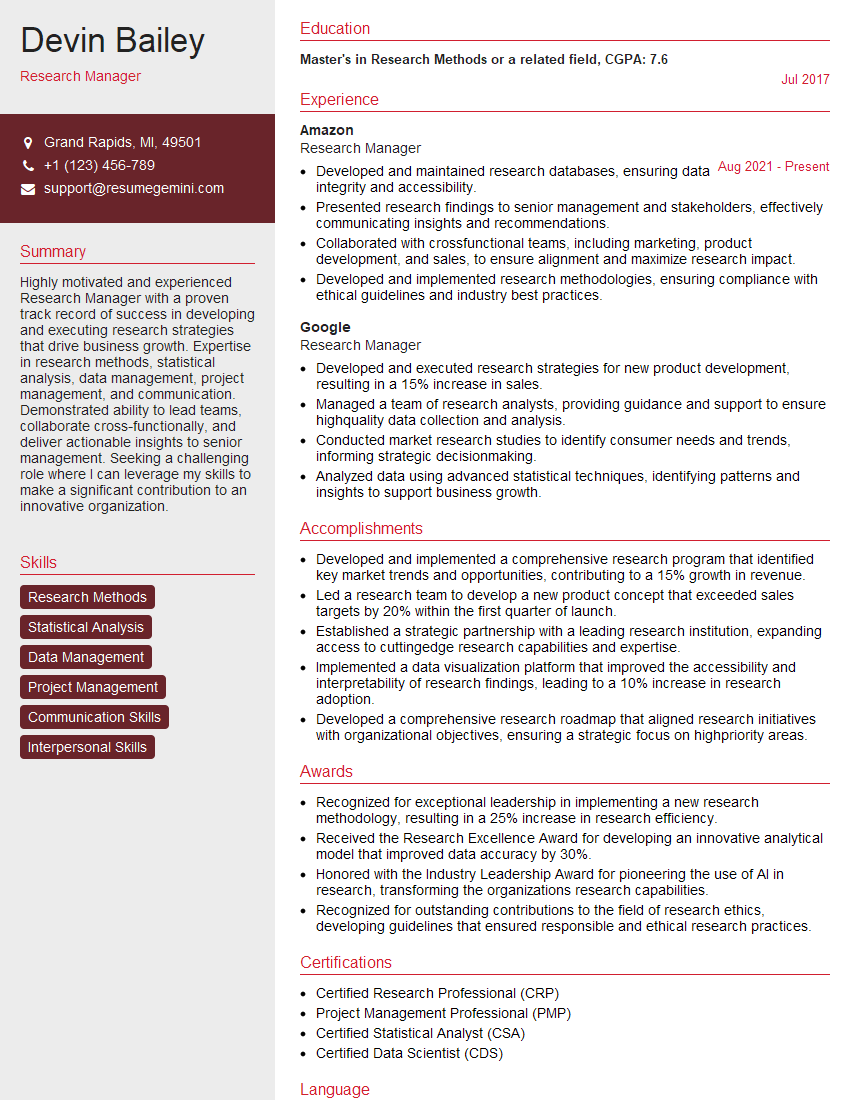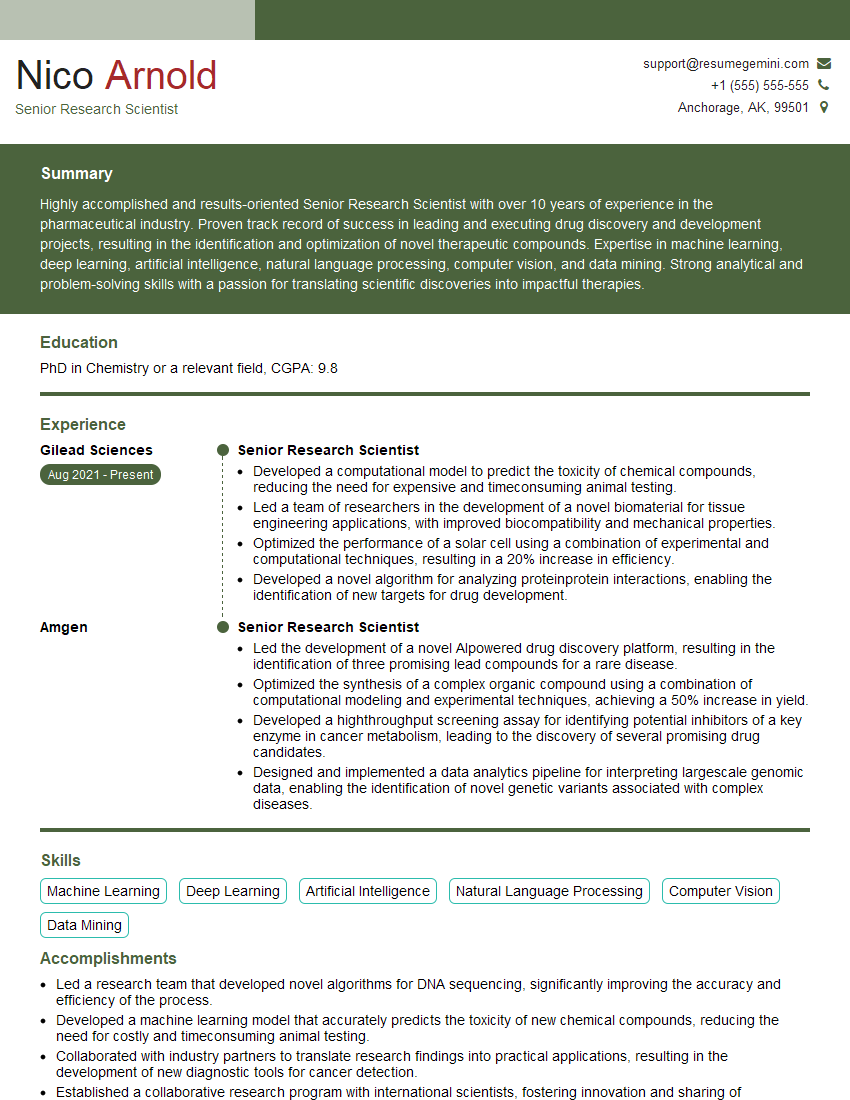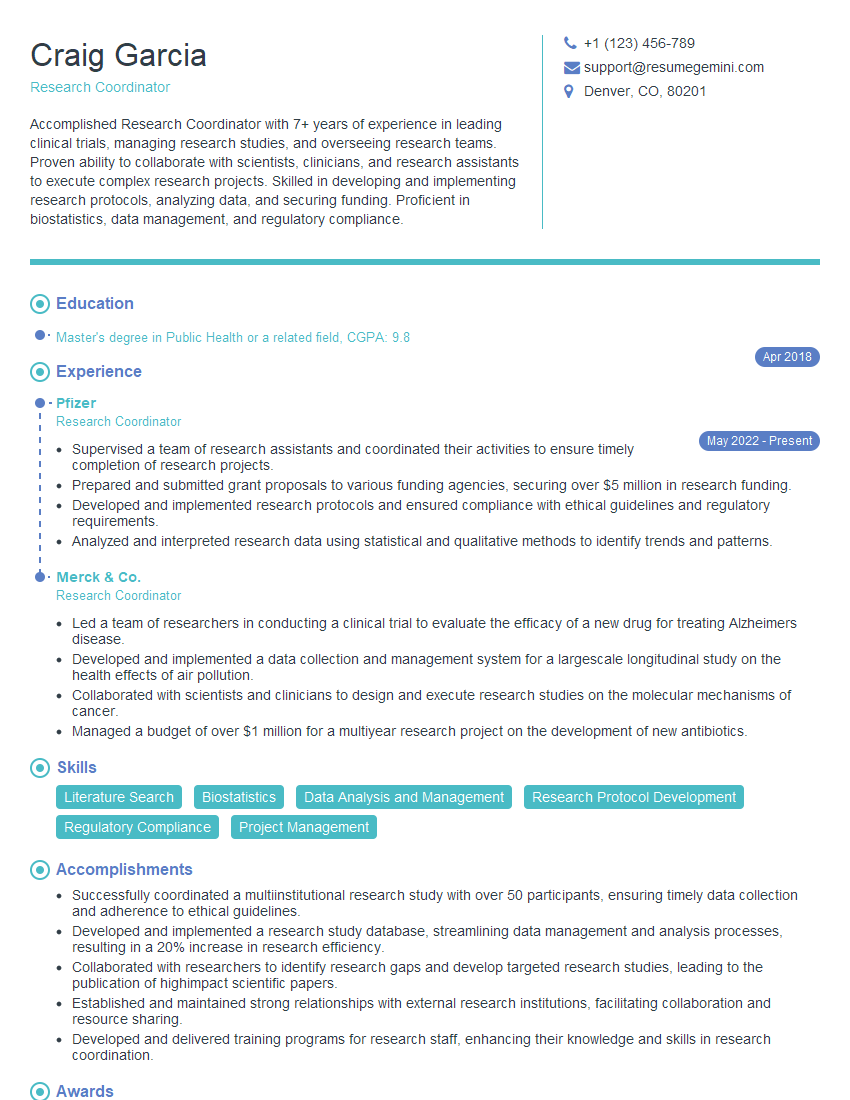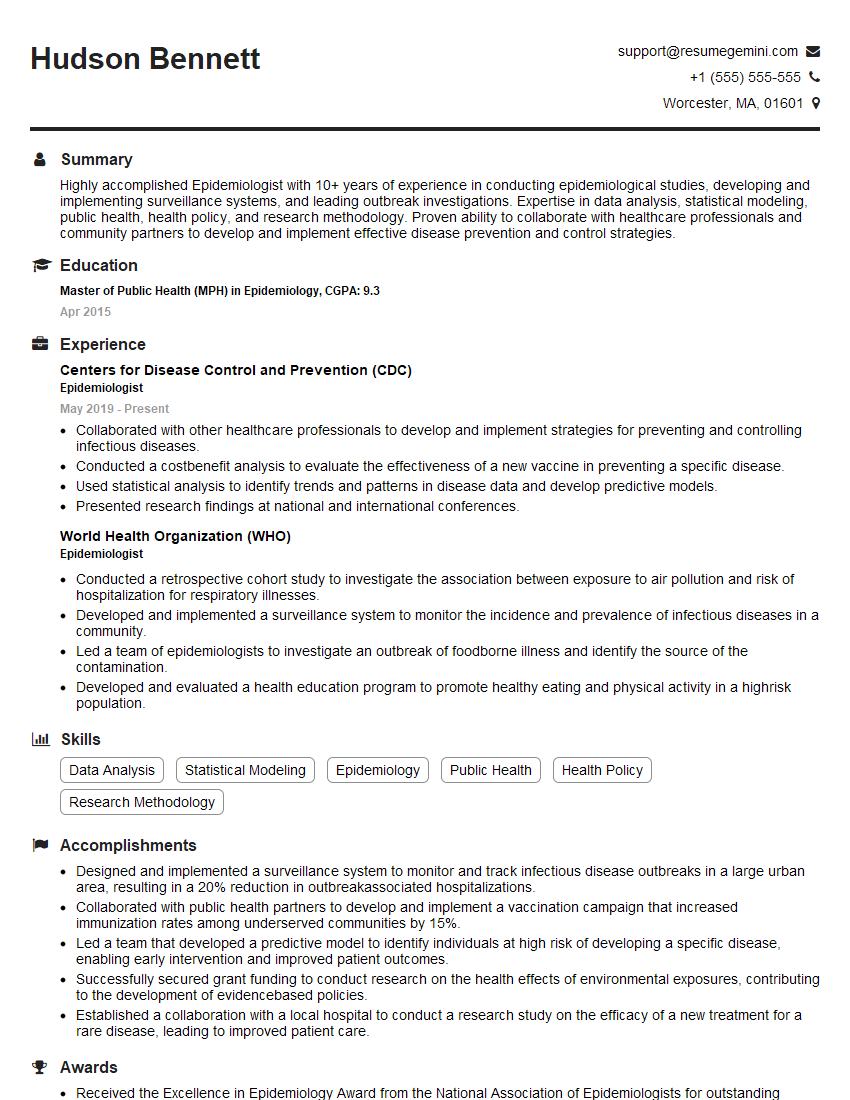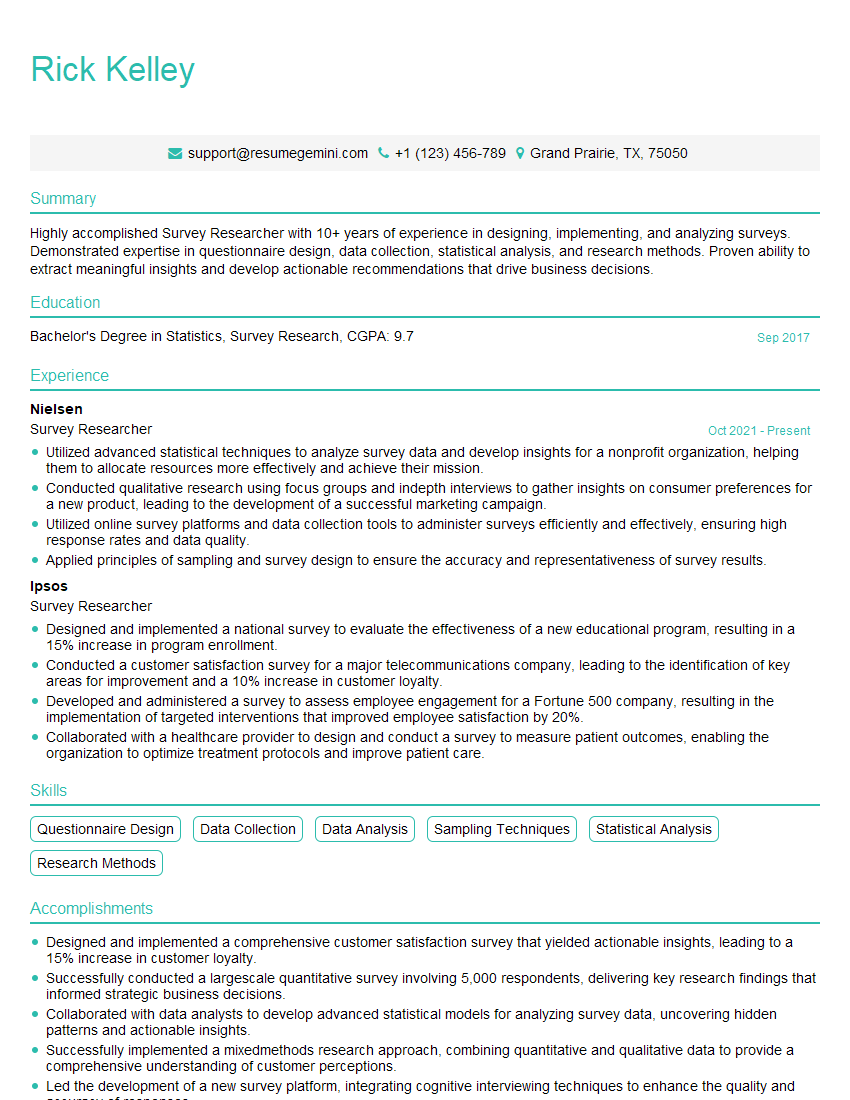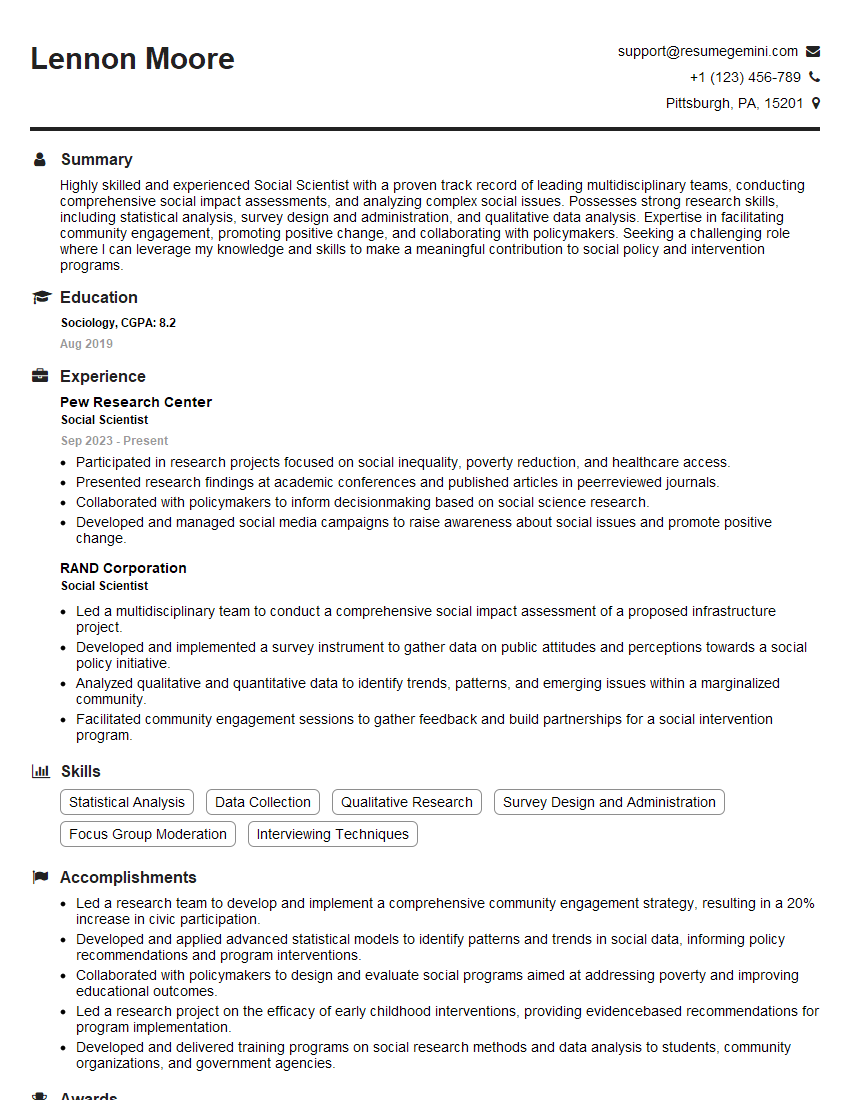Feeling uncertain about what to expect in your upcoming interview? We’ve got you covered! This blog highlights the most important Research Methodology and Statistics interview questions and provides actionable advice to help you stand out as the ideal candidate. Let’s pave the way for your success.
Questions Asked in Research Methodology and Statistics Interview
Q 1. Explain the difference between Type I and Type II errors.
Type I and Type II errors are both errors that can occur in hypothesis testing. They represent different kinds of mistakes we can make when deciding whether to reject or fail to reject a null hypothesis.
Type I Error (False Positive): This occurs when we reject the null hypothesis when it is actually true. Think of it like a fire alarm going off when there’s no fire. We’ve made a false claim of finding a significant effect when there isn’t one. The probability of making a Type I error is denoted by alpha (α), often set at 0.05 (5%).
Type II Error (False Negative): This happens when we fail to reject the null hypothesis when it is actually false. Imagine a doctor missing a disease diagnosis – they’ve failed to identify a real effect. The probability of making a Type II error is denoted by beta (β). The power of a statistical test (1-β) represents the probability of correctly rejecting a false null hypothesis.
Example: Let’s say we’re testing a new drug. The null hypothesis is that the drug has no effect. A Type I error would be concluding the drug is effective when it’s not. A Type II error would be concluding the drug is ineffective when it actually is effective.
Minimizing both types of errors is crucial in research. The balance between them often involves trade-offs, as reducing one type may increase the other.
Q 2. What are the assumptions of linear regression?
Linear regression assumes a linear relationship between the dependent and independent variables. Several other assumptions must also be met for the results to be reliable and valid.
- Linearity: The relationship between the dependent and independent variables is linear. A scatter plot can help visualize this.
- Independence of errors: The errors (residuals) are independent of each other. This means that the error in one observation does not influence the error in another observation. Autocorrelation can violate this assumption.
- Homoscedasticity: The variance of the errors is constant across all levels of the independent variable. This means the spread of the residuals is consistent throughout the range of the predictor variable. Heteroscedasticity, where the variance changes, violates this assumption.
- Normality of errors: The errors are normally distributed. This assumption is often less critical with larger sample sizes due to the central limit theorem.
- No multicollinearity: In multiple linear regression, the independent variables should not be highly correlated with each other. High multicollinearity can inflate standard errors and make it difficult to interpret the coefficients.
- No outliers: Outliers (extreme values) can significantly influence the regression results. They should be investigated and handled appropriately (e.g., removal or transformation).
Violating these assumptions can lead to biased or inefficient estimates, impacting the reliability of the model. Diagnostic plots and statistical tests can be used to assess the validity of these assumptions.
Q 3. Describe different sampling techniques and their applications.
Sampling techniques are crucial for selecting a representative subset of a population to conduct research efficiently. Choosing the right technique depends on the research question and the characteristics of the population.
- Simple Random Sampling: Every member of the population has an equal chance of being selected. This is like drawing names out of a hat. It’s easy to implement but might not be representative if the population is diverse.
- Stratified Random Sampling: The population is divided into strata (subgroups) based on relevant characteristics, and then a random sample is drawn from each stratum. This ensures representation from all subgroups, useful for understanding differences between groups.
- Cluster Sampling: The population is divided into clusters (groups), and a random sample of clusters is selected. Then, all members within the selected clusters are included in the sample. This is cost-effective when the population is geographically dispersed.
- Systematic Sampling: Every kth member of the population is selected after a random starting point. This is simple but can be problematic if there’s a pattern in the population.
- Convenience Sampling: Selecting participants based on their availability or ease of access. This is quick but introduces bias and lacks generalizability.
Example: A researcher studying student satisfaction might use stratified random sampling to ensure representation from different academic years and majors. A national survey might use cluster sampling by selecting a sample of counties and then surveying households within those counties.
Q 4. How do you handle missing data in a dataset?
Missing data is a common problem in research. The best approach depends on the nature of the missing data (missing completely at random (MCAR), missing at random (MAR), or missing not at random (MNAR)) and the extent of the missingness.
- Listwise Deletion: Removing any observations with missing values. This is simple but can lead to significant loss of information if there’s a substantial amount of missing data. It’s only appropriate if data is MCAR.
- Pairwise Deletion: Using available data for each analysis. This can lead to inconsistent results as different analyses use different subsets of the data.
- Imputation: Replacing missing values with estimated values. Methods include mean/median imputation (simple but can bias results), regression imputation (predicts missing values based on other variables), and multiple imputation (generates several plausible imputed datasets). Multiple imputation is generally preferred for its ability to account for uncertainty in imputed values.
Example: In a survey on consumer preferences, if some respondents skip questions about their income, mean imputation might be a simple but potentially inaccurate solution. Regression imputation, using other variables like age and occupation to predict missing incomes, may be a more accurate approach. Multiple imputation would provide a more robust analysis by considering the uncertainty introduced by the imputed values.
Q 5. Explain the concept of statistical significance.
Statistical significance refers to the probability that an observed effect is not due to chance. It’s a measure of how likely it is that the results of a study are real and not just the result of random variation.
In hypothesis testing, we typically set a significance level (alpha, α), usually at 0.05. If the p-value (the probability of obtaining the observed results if the null hypothesis is true) is less than α, we reject the null hypothesis and conclude that the result is statistically significant. This means the probability of observing the obtained results is less than 5% if there is no true effect.
Important Note: Statistical significance doesn’t automatically imply practical significance. A statistically significant result might have a small effect size that is not meaningful in a real-world context. It’s crucial to consider both statistical and practical significance when interpreting results.
Q 6. What is the difference between correlation and causation?
Correlation and causation are often confused but represent distinct concepts.
Correlation: This describes the relationship between two or more variables. A correlation coefficient (e.g., Pearson’s r) measures the strength and direction of the linear association. A positive correlation indicates that as one variable increases, the other tends to increase, while a negative correlation indicates that as one variable increases, the other tends to decrease. Correlation does not imply causation.
Causation: This implies that one variable directly influences or causes a change in another variable. Establishing causation requires demonstrating a cause-and-effect relationship.
Example: Ice cream sales and crime rates might be positively correlated (both increase during summer), but this doesn’t mean eating ice cream causes crime. A confounding variable, like hot weather, could be driving both. To establish causation, you’d need to demonstrate a mechanism through which one variable directly influences the other.
Q 7. Describe different types of research designs (e.g., experimental, observational).
Research designs are the frameworks used to structure a study and collect data. Different designs are suited to different research questions and objectives.
- Experimental Designs: These involve manipulating an independent variable to observe its effect on a dependent variable while controlling other factors. Random assignment of participants to different groups is a key feature. This allows for strong causal inferences (if done correctly). Examples include randomized controlled trials and A/B testing.
- Observational Designs: These involve observing and measuring variables without manipulating them. Researchers don’t interfere with the natural course of events. This is useful for studying phenomena that cannot be ethically or practically manipulated. Examples include cohort studies, case-control studies, and cross-sectional studies. Establishing causation is more challenging with observational designs due to the potential for confounding variables.
- Qualitative Research Designs: These involve in-depth exploration of a phenomenon through methods like interviews, focus groups, and document analysis. They aim to understand experiences, perspectives, and meanings rather than quantifying relationships.
The choice of research design depends on the research question, resources, ethical considerations, and the nature of the variables being studied.
Q 8. What are the key steps in conducting a hypothesis test?
Hypothesis testing is a crucial process in research, allowing us to make inferences about a population based on sample data. It involves a structured series of steps to determine whether there’s enough evidence to reject a null hypothesis – a statement of no effect or no difference.
- State the Hypotheses: Formulate a null hypothesis (H0) representing the status quo and an alternative hypothesis (H1 or Ha) representing the research hypothesis. For example, if testing a new drug, H0 might be ‘the drug has no effect on blood pressure,’ while H1 would be ‘the drug lowers blood pressure’.
- Set the Significance Level (α): This determines the probability of rejecting the null hypothesis when it’s actually true (Type I error). A common significance level is 0.05 (5%), meaning we’re willing to accept a 5% chance of a false positive.
- Choose the Appropriate Test Statistic: Select a statistical test based on the type of data (e.g., t-test, ANOVA, chi-square test), the research question, and the assumptions of the test. This choice is critical for valid results.
- Calculate the Test Statistic and p-value: Using the chosen test, calculate the test statistic based on your sample data. The p-value is the probability of observing the obtained results (or more extreme results) if the null hypothesis is true.
- Make a Decision: Compare the p-value to the significance level (α). If the p-value is less than or equal to α, reject the null hypothesis. Otherwise, fail to reject the null hypothesis. This decision is based on the evidence from the sample data and the pre-set level of risk for error.
- Interpret the Results: Clearly state your conclusion in the context of your research question. This involves explaining the implications of rejecting or failing to reject the null hypothesis.
For instance, imagine testing if a new teaching method improves test scores. After conducting a t-test, you obtain a p-value of 0.03. Since 0.03 < 0.05, you would reject the null hypothesis (that the teaching method has no effect) and conclude that the new method significantly improves test scores.
Q 9. Explain the central limit theorem.
The Central Limit Theorem (CLT) is a cornerstone of statistical inference. It states that the distribution of the sample means (or averages) from a large number of independent, identically distributed random variables will approximate a normal distribution, regardless of the shape of the original population distribution. The key aspects are:
- Sample Size: The CLT works best with larger sample sizes (generally, n ≥ 30). The larger the sample, the closer the distribution of sample means will be to a normal distribution.
- Independence: The observations within each sample should be independent of each other. This means one observation doesn’t influence another.
- Identically Distributed: The observations should come from the same population and have the same underlying distribution (although the shape of that distribution doesn’t matter for the CLT).
Imagine repeatedly taking samples of, say, the heights of students from a university. Even if the population distribution of student heights is not perfectly normal (it might be slightly skewed), the distribution of the average heights from many samples will be very close to a normal distribution. This allows us to use normal distribution-based statistical tests even if we don’t know the original population distribution.
This is incredibly useful because many statistical tests rely on the assumption of normality, and the CLT enables us to meet this assumption even when dealing with non-normal populations.
Q 10. How do you choose the appropriate statistical test for a given research question?
Choosing the right statistical test is crucial for obtaining valid and reliable results. The selection depends on several factors:
- Type of Data: Is your data categorical (nominal or ordinal) or numerical (interval or ratio)? Different tests are suitable for different data types.
- Research Question: Are you comparing means, proportions, or associations? Are you testing for differences or relationships?
- Number of Groups: Are you comparing two groups, more than two groups, or looking at relationships between variables?
- Assumptions of the Test: Certain tests require assumptions about the data, such as normality and independence. Violating these assumptions can lead to inaccurate results.
Here’s a simplified approach:
- Identify the data type: Categorical or numerical?
- Identify the research question: Difference, association, or relationship?
- Determine the number of groups or variables: Two groups, multiple groups, or one variable?
- Consult a statistical test selection guide or flowchart: These resources guide you based on your answers.
For example, if you’re comparing the means of two independent groups with normally distributed data, a t-test is appropriate. If you’re comparing the means of more than two groups, ANOVA would be more suitable. For examining the association between two categorical variables, a chi-square test is often used.
Q 11. What is the difference between parametric and non-parametric tests?
Parametric and non-parametric tests are two broad categories of statistical tests. The primary difference lies in their assumptions about the data:
- Parametric Tests: These tests assume that the data follows a specific probability distribution, often a normal distribution. They also assume that the data is measured on an interval or ratio scale. Examples include t-tests, ANOVA, and Pearson correlation. These tests are generally more powerful (i.e., more likely to detect a true effect) when their assumptions are met.
- Non-parametric Tests: These tests make fewer assumptions about the data distribution. They can be used with ordinal or ranked data and are less sensitive to outliers. Examples include Mann-Whitney U test, Wilcoxon signed-rank test, and Spearman rank correlation. These tests are more robust to violations of assumptions but are generally less powerful than parametric tests if the assumptions of the parametric test are met.
In essence, if your data meets the assumptions of a parametric test (e.g., normality), a parametric test is generally preferred due to its higher power. However, if your data violates these assumptions, a non-parametric test provides a more reliable analysis. The choice often involves a trade-off between power and robustness.
Q 12. Explain the concept of confidence intervals.
A confidence interval (CI) provides a range of values within which a population parameter (e.g., mean, proportion) is likely to fall with a certain degree of confidence. It’s expressed as a percentage, commonly 95%. A 95% CI means that if you were to repeat the study many times, 95% of the calculated confidence intervals would contain the true population parameter.
A confidence interval is typically expressed as:
Point Estimate ± Margin of Error
The point estimate is the sample statistic (e.g., sample mean), and the margin of error reflects the uncertainty associated with the estimate. The wider the interval, the greater the uncertainty.
For example, a 95% confidence interval for the average height of adult women might be 162 cm ± 2 cm (160 cm to 164 cm). This means we are 95% confident that the true average height of adult women in the population lies between 160 cm and 164 cm.
Confidence intervals are valuable because they provide a measure of uncertainty around the point estimate, conveying a more complete picture than just the estimate itself. They give a sense of the precision of the estimate, showing how much the estimate might vary from the true population parameter.
Q 13. What are some common measures of central tendency and dispersion?
Measures of central tendency describe the center or typical value of a dataset, while measures of dispersion describe the spread or variability of the data.
Measures of Central Tendency:
- Mean: The average of all values (sum of values divided by the number of values). Sensitive to outliers.
- Median: The middle value when the data is ordered. Less sensitive to outliers than the mean.
- Mode: The most frequent value. Can be used for categorical data.
Measures of Dispersion:
- Range: The difference between the highest and lowest values. Very sensitive to outliers.
- Variance: The average of the squared differences from the mean. Provides a measure of how spread out the data is.
- Standard Deviation: The square root of the variance. Expressed in the same units as the original data, making it easier to interpret than variance.
- Interquartile Range (IQR): The difference between the 75th percentile (Q3) and the 25th percentile (Q1) of the data. Robust to outliers.
Choosing the appropriate measure depends on the data’s distribution and the research question. For example, the median is preferred over the mean when dealing with skewed data or outliers, as it’s less influenced by extreme values.
Q 14. How do you interpret a p-value?
The p-value is the probability of observing the obtained results (or more extreme results) if the null hypothesis is true. It’s a crucial component of hypothesis testing.
Interpretation:
- Low p-value (typically ≤ 0.05): This suggests that the observed results are unlikely to have occurred by chance alone if the null hypothesis were true. We would reject the null hypothesis in favor of the alternative hypothesis.
- High p-value (typically > 0.05): This indicates that the observed results are likely to have occurred by chance if the null hypothesis were true. We would fail to reject the null hypothesis. This does *not* mean we accept the null hypothesis, only that we don’t have enough evidence to reject it.
It’s important to remember that the p-value doesn’t provide the probability that the null hypothesis is true. It only reflects the probability of the data given the null hypothesis. Furthermore, the choice of the significance level (α) is arbitrary; a p-value of 0.049 might be interpreted differently than 0.051 despite their proximity.
A small p-value strengthens the evidence against the null hypothesis, supporting the alternative hypothesis. However, the p-value should always be interpreted within the context of the study design, sample size, and effect size.
Q 15. Describe different methods for data visualization.
Data visualization is the graphical representation of information and data. It allows us to see patterns, trends, and outliers in data more easily than by looking at numbers alone. Effective visualization is crucial for communicating research findings clearly and concisely. There are numerous methods, each suited to different data types and research questions.
- Bar charts and histograms: Ideal for showing the frequency distribution of categorical or numerical data. Think of comparing the number of participants in different experimental groups or visualizing the distribution of age in a sample.
- Line graphs: Excellent for displaying trends over time. For instance, tracking changes in a stock price, or the growth of a bacterial colony over several hours.
- Scatter plots: Show the relationship between two numerical variables. You might use a scatter plot to explore the correlation between study time and exam scores.
- Pie charts: Useful for displaying proportions or percentages of a whole. For example, showing the percentage of respondents who chose each answer option in a survey.
- Box plots: Effectively display the distribution of data, including median, quartiles, and outliers. Useful for comparing the distributions across different groups.
- Heatmaps: Represent data as colors, useful for visualizing large matrices or correlation tables. Imagine visualizing gene expression levels across different tissues.
- Geographic maps: Show data distributed across geographic locations. Example: Mapping disease incidence rates across different states.
Choosing the right visualization depends heavily on the type of data and the story you want to tell. A poorly chosen chart can obscure important information or mislead the audience.
Career Expert Tips:
- Ace those interviews! Prepare effectively by reviewing the Top 50 Most Common Interview Questions on ResumeGemini.
- Navigate your job search with confidence! Explore a wide range of Career Tips on ResumeGemini. Learn about common challenges and recommendations to overcome them.
- Craft the perfect resume! Master the Art of Resume Writing with ResumeGemini’s guide. Showcase your unique qualifications and achievements effectively.
- Don’t miss out on holiday savings! Build your dream resume with ResumeGemini’s ATS optimized templates.
Q 16. How do you assess the reliability and validity of a research instrument?
Assessing the reliability and validity of a research instrument is crucial for ensuring the quality and trustworthiness of research findings. Reliability refers to the consistency of a measurement, while validity refers to whether the instrument actually measures what it intends to measure.
Reliability can be assessed through:
- Test-retest reliability: Administering the same instrument to the same group at two different times and correlating the scores. High correlation indicates good reliability.
- Internal consistency reliability (Cronbach’s alpha): Measures the consistency of items within the instrument. A high alpha (typically above 0.7) suggests good internal consistency.
- Inter-rater reliability: Assessing the agreement between multiple raters using the same instrument. Cohen’s Kappa is often used to quantify agreement.
Validity can be assessed through:
- Content validity: Ensuring the instrument covers all relevant aspects of the construct being measured. This often involves expert judgment.
- Criterion validity: Assessing the instrument’s correlation with an external criterion. For example, correlating scores on a new anxiety scale with scores on an established anxiety scale (concurrent validity) or future performance (predictive validity).
- Construct validity: Determining whether the instrument measures the theoretical construct it is intended to measure. This often involves factor analysis or other statistical techniques.
In practice, researchers often employ multiple methods to assess both reliability and validity. For example, a new questionnaire might undergo pilot testing to refine its content, then its reliability and different aspects of its validity are rigorously assessed before use in a larger study.
Q 17. Explain the concept of effect size.
Effect size quantifies the magnitude of an effect observed in a study. It tells us how strong the relationship is between variables or how large the difference is between groups, independent of sample size. A large effect size indicates a substantial effect, while a small effect size indicates a weak effect.
Different effect size measures exist depending on the type of statistical test used:
- Cohen’s d (for t-tests and ANOVA): Represents the difference between two group means in terms of standard deviation. Generally, d = 0.2 is considered small, d = 0.5 medium, and d = 0.8 large.
- Pearson’s r (for correlations): Indicates the strength and direction of a linear relationship between two variables. r = 0.1 is small, r = 0.3 is medium, and r = 0.5 is large.
- Odds ratio (for logistic regression): Indicates the odds of an outcome occurring in one group compared to another.
- Eta-squared (η²) (for ANOVA): Represents the proportion of variance in the dependent variable explained by the independent variable.
Reporting effect sizes is crucial because statistical significance (p-value) can be affected by sample size. A small effect might be statistically significant with a very large sample, but it may not be practically meaningful. Effect size provides a more complete picture of the research findings.
Q 18. What is the difference between descriptive and inferential statistics?
Descriptive and inferential statistics serve different purposes in data analysis.
Descriptive statistics summarize and describe the main features of a dataset. They don’t allow us to make generalizations beyond the data we have collected. Examples include:
- Measures of central tendency: Mean, median, mode
- Measures of dispersion: Standard deviation, variance, range
- Frequencies and percentages: Showing the number or proportion of observations in each category.
Inferential statistics go beyond describing the sample data. They allow us to make inferences about a larger population based on the sample data. This involves using probability theory to test hypotheses and estimate population parameters. Examples include:
- Hypothesis testing (t-tests, ANOVA, chi-square tests): Determining if there’s enough evidence to reject a null hypothesis.
- Confidence intervals: Providing a range of values within which a population parameter is likely to fall.
- Regression analysis: Modeling the relationship between variables and predicting outcomes.
Imagine a survey on customer satisfaction. Descriptive statistics would tell you the average satisfaction score and the distribution of scores. Inferential statistics would allow you to test if the average satisfaction score is significantly different between different customer segments or to predict satisfaction based on other variables.
Q 19. How do you deal with outliers in your data?
Outliers are data points that significantly deviate from the rest of the data. They can skew results and distort the interpretation of findings. Handling outliers requires careful consideration and depends on the context and the cause of the outlier.
Here’s a stepwise approach:
- Identify outliers: Use visual methods (box plots, scatter plots) and statistical methods (Z-scores, interquartile range (IQR)).
- Investigate the cause: Determine if the outlier is due to a genuine phenomenon, measurement error, data entry error, or other issues.
- Decide on a course of action: Based on the cause, several options exist:
- Correct errors: If the outlier is due to an error, correct it.
- Remove outliers: This should be done cautiously and only if justified. Clearly document the rationale for removal. Consider using robust statistical methods that are less sensitive to outliers (e.g., median instead of mean).
- Transform data: Apply a transformation (e.g., log transformation) to reduce the influence of outliers.
- Use robust statistical methods: These methods are less sensitive to outliers, e.g., median, trimmed mean.
- Analyze data with and without outliers: Compare the results. If the conclusions change substantially, discuss this in the analysis.
It’s crucial to avoid arbitrarily removing outliers to obtain desired results. Transparency and careful justification are key aspects of responsible data analysis.
Q 20. What is A/B testing and how is it used?
A/B testing, also known as split testing, is a randomized experiment used to compare two versions of a variable (A and B) to determine which performs better. This is widely used in website optimization, marketing campaigns, and app development. The goal is to identify the version that yields the desired outcome, such as higher conversion rates, improved user engagement, or increased click-through rates.
How it works:
- Define a hypothesis: Formulate a clear hypothesis about what you expect to happen. For instance, "Version B of the website’s landing page will result in a higher conversion rate than Version A."
- Create variations: Develop two versions (A and B) of the element you are testing (e.g., website headline, button color, email subject line).
- Randomly assign participants: Divide the target audience into two groups randomly, exposing each group to one of the versions.
- Measure results: Track the key metrics (conversion rate, click-through rate, etc.) for each version.
- Analyze data: Use statistical tests (e.g., t-test, chi-square test) to determine if there’s a statistically significant difference between the performance of the two versions.
- Implement the winning version: If one version significantly outperforms the other, implement it for a wider audience.
Example: A company might test two different email subject lines (A and B) to see which one generates more opens and clicks. By randomly sending each subject line to different segments of their email list, they can determine which subject line performs better and then use the winning version for their broader email marketing campaign. A/B testing provides data-driven insights to optimize various aspects of a business.
Q 21. Explain your understanding of Bayesian statistics.
Bayesian statistics is a framework for statistical inference that incorporates prior knowledge or beliefs about the parameters of interest. Unlike frequentist statistics, which focuses on the frequency of events, Bayesian statistics uses Bayes’ theorem to update our beliefs about these parameters based on new evidence. The core of this approach is Bayes’ Theorem:
P(A|B) = [P(B|A) * P(A)] / P(B)
Where:
P(A|B)is the posterior probability of event A given event B.P(B|A)is the likelihood of event B given event A.P(A)is the prior probability of event A.P(B)is the prior probability of event B (also called the evidence).
In simpler terms, Bayesian statistics starts with a prior belief (prior distribution) about a parameter, then updates this belief using observed data (likelihood) to obtain a posterior distribution. The posterior distribution represents our updated belief after observing the data. This iterative process allows for learning and refinement of our understanding.
Example: Suppose you are estimating the probability of a coin being biased towards heads. Your prior belief might be that it’s a fair coin (prior probability of 0.5). After flipping the coin 10 times and observing 8 heads, the Bayesian approach would update your belief, resulting in a posterior probability that is higher than 0.5, reflecting the evidence from the experiment. Bayesian statistics is particularly useful when prior knowledge is available or when dealing with small sample sizes.
Q 22. How do you choose between different regression models?
Choosing the right regression model depends heavily on the nature of your data and your research question. It’s not a one-size-fits-all situation. We start by considering the type of dependent variable (continuous, binary, count, etc.) and the characteristics of the independent variables (linearity, normality, homoscedasticity).
Linear Regression: Used when the dependent variable is continuous and the relationship between the independent and dependent variables is linear. Think predicting house prices based on size and location. We’d assess the assumptions (linearity, independence of errors, normality of errors, homoscedasticity) to ensure its appropriateness.
Logistic Regression: Ideal for predicting a binary outcome (e.g., success/failure, yes/no). For example, predicting customer churn based on usage patterns. Here, we’re interested in the probability of the event occurring.
Poisson Regression: Appropriate for count data, like the number of accidents at an intersection. It models the rate of events occurring.
Multinomial Logistic Regression: Used when the dependent variable has more than two unordered categories (e.g., predicting the type of vehicle a person will buy).
Model selection often involves comparing models using metrics like AIC (Akaike Information Criterion) and BIC (Bayesian Information Criterion). Lower values indicate a better fit, balancing model complexity with explanatory power. We also check for overfitting by comparing the model’s performance on training and testing datasets.
Furthermore, I always visually inspect my data through scatter plots and residual plots to ensure the assumptions are met. If assumptions are violated, I explore transformations (e.g., log transformation) or consider alternative models.
Q 23. Describe your experience with statistical software packages (e.g., R, SPSS, SAS).
I have extensive experience with R, SPSS, and SAS. My R skills include data manipulation with dplyr, data visualization with ggplot2, and statistical modeling using packages like lm (linear regression), glm (generalized linear models), and more advanced techniques such as mixed-effects models. In SPSS, I’m proficient in conducting various statistical tests, regression analyses, and creating descriptive statistics. With SAS, my expertise lies in handling large datasets, performing complex statistical procedures, and generating publication-ready reports. I’m comfortable with the syntax of each program and adapt my choice based on the project’s requirements and the available resources. For instance, for large datasets requiring efficient processing, I would prefer SAS, while for rapid prototyping and visualization, R is usually my go-to tool. SPSS is useful for its user-friendly interface when working with colleagues less familiar with statistical software.
Q 24. Explain your experience with data cleaning and preprocessing.
Data cleaning and preprocessing are crucial steps, often consuming a significant portion of the analysis time. My approach involves a structured process:
Handling Missing Data: I assess the extent and pattern of missing data. Methods include imputation (e.g., mean imputation, k-nearest neighbors) or exclusion of variables/observations, depending on the nature and amount of missingness. The choice is justified based on the nature of data and impact on the analysis.
Outlier Detection and Treatment: I identify outliers using box plots, scatter plots, and statistical methods like the interquartile range (IQR). Depending on the context, I may remove them, transform the data (e.g., log transformation), or use robust statistical methods less sensitive to outliers.
Data Transformation: This may involve converting variables to different scales (e.g., standardizing or normalizing) to meet the assumptions of certain statistical tests or improve model performance.
Data Consistency: I check for inconsistencies in data entry, coding, and units of measurement. This includes correcting errors, recoding variables, and ensuring data types are appropriate.
For example, in a study on customer satisfaction, I encountered inconsistent responses due to ambiguous survey questions. I had to recode the data based on additional information to make sure the data accurately reflected customer feelings.
Q 25. How do you ensure the ethical considerations in research?
Ethical considerations are paramount in research. My approach includes:
Informed Consent: Ensuring participants are fully informed about the study’s purpose, procedures, risks, and benefits before providing consent.
Confidentiality and Anonymity: Protecting the privacy of participants by anonymizing data and securely storing it. I use appropriate techniques to de-identify data while maintaining data integrity.
Data Security: Implementing measures to protect data from unauthorized access, use, disclosure, disruption, modification, or destruction.
Avoiding Bias: Being aware of potential biases in the research design, data collection, and analysis and taking steps to mitigate them. This includes careful consideration of sampling methods and blinding procedures where appropriate.
Transparency and Reporting: Clearly reporting the research methods, results, and limitations. This includes acknowledging any limitations of the study or potential sources of bias.
Institutional Review Board (IRB) Approval: Securing IRB approval for any research involving human subjects, ensuring that the study complies with ethical guidelines.
I am deeply committed to conducting research in a responsible and ethical manner, prioritizing the well-being and rights of participants.
Q 26. Describe a time you had to troubleshoot a statistical analysis.
In a recent project analyzing customer purchase data, I encountered unexpectedly high leverage points that significantly influenced my regression model. Initially, the model’s R-squared was very high, but the predictions were poor on new data. I investigated the influential points by examining Cook’s distance and leverage plots. It turned out these data points represented bulk orders from a single wholesaler, significantly different from typical customer purchases. I initially considered removing them but realized that excluding them would bias the model towards typical customer behavior and fail to capture this important segment. Instead, I created a new variable to flag wholesale orders, allowing me to include the points while accounting for their distinct nature within the model using interaction terms. This resulted in a more robust and accurate model that better reflected the nuances of the customer base.
Q 27. What are your strengths and weaknesses in research methodology and statistics?
Strengths: My strengths lie in my strong foundation in statistical theory, combined with practical experience applying various statistical methods. I possess advanced skills in statistical software and a meticulous approach to data analysis, ensuring accuracy and rigor. I’m also adept at communicating complex statistical concepts clearly and effectively, both verbally and in writing. I’m comfortable working independently and also thrive in collaborative environments.
Weaknesses: While I’m proficient in various statistical techniques, I’m always striving to expand my knowledge in areas like Bayesian statistics and causal inference. I’m also conscious of the time it can take to thoroughly explore all possible methodologies. I actively address this by focusing my efforts on the most appropriate methods given the research question and available resources, while staying aware of potential limitations of my chosen approaches. I view ongoing learning and exploration as vital to maintaining my expertise.
Key Topics to Learn for Research Methodology and Statistics Interview
- Research Design: Understand different research designs (experimental, quasi-experimental, observational), their strengths, weaknesses, and appropriate applications. Consider scenarios where you’d choose one design over another.
- Data Collection Methods: Explore various data collection techniques (surveys, interviews, experiments, existing datasets) and their implications for data quality and analysis. Be prepared to discuss the pros and cons of each method.
- Sampling Techniques: Master different sampling methods (random, stratified, cluster) and their impact on sample representativeness and generalizability of findings. Practice calculating sample size for different scenarios.
- Descriptive Statistics: Be comfortable with measures of central tendency (mean, median, mode), variability (variance, standard deviation), and data visualization techniques. Prepare to interpret descriptive statistics in context.
- Inferential Statistics: Understand hypothesis testing, confidence intervals, and common statistical tests (t-tests, ANOVA, chi-square). Practice interpreting p-values and effect sizes.
- Regression Analysis: Familiarize yourself with linear and multiple regression, interpreting regression coefficients, and assessing model fit. Be ready to discuss assumptions and limitations.
- Qualitative Data Analysis: Understand techniques for analyzing qualitative data, such as thematic analysis, grounded theory, and content analysis. Be prepared to discuss how qualitative and quantitative methods can be combined.
- Ethical Considerations: Demonstrate understanding of ethical principles in research, including informed consent, confidentiality, and data security. Be prepared to discuss ethical dilemmas in research.
- Data Interpretation and Communication: Practice clearly and concisely communicating research findings, both verbally and in writing, to diverse audiences. Focus on conveying the implications of your findings.
- Statistical Software Proficiency: Highlight your experience with statistical software packages (e.g., R, SPSS, SAS). Be prepared to discuss your proficiency in data cleaning, manipulation, and analysis.
Next Steps
Mastering Research Methodology and Statistics is crucial for career advancement in many fields, opening doors to exciting opportunities and showcasing your analytical and problem-solving skills. A strong resume is your first impression; make it count! Create an ATS-friendly resume that highlights your key skills and accomplishments to maximize your job prospects. ResumeGemini is a trusted resource that can help you build a professional and impactful resume. They provide examples of resumes tailored to Research Methodology and Statistics to guide you through the process. Invest the time – it will pay off significantly.
Explore more articles
Users Rating of Our Blogs
Share Your Experience
We value your feedback! Please rate our content and share your thoughts (optional).
What Readers Say About Our Blog
This was kind of a unique content I found around the specialized skills. Very helpful questions and good detailed answers.
Very Helpful blog, thank you Interviewgemini team.
